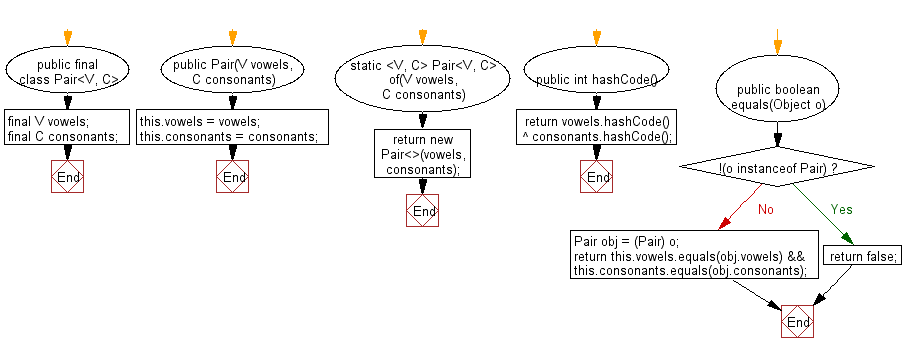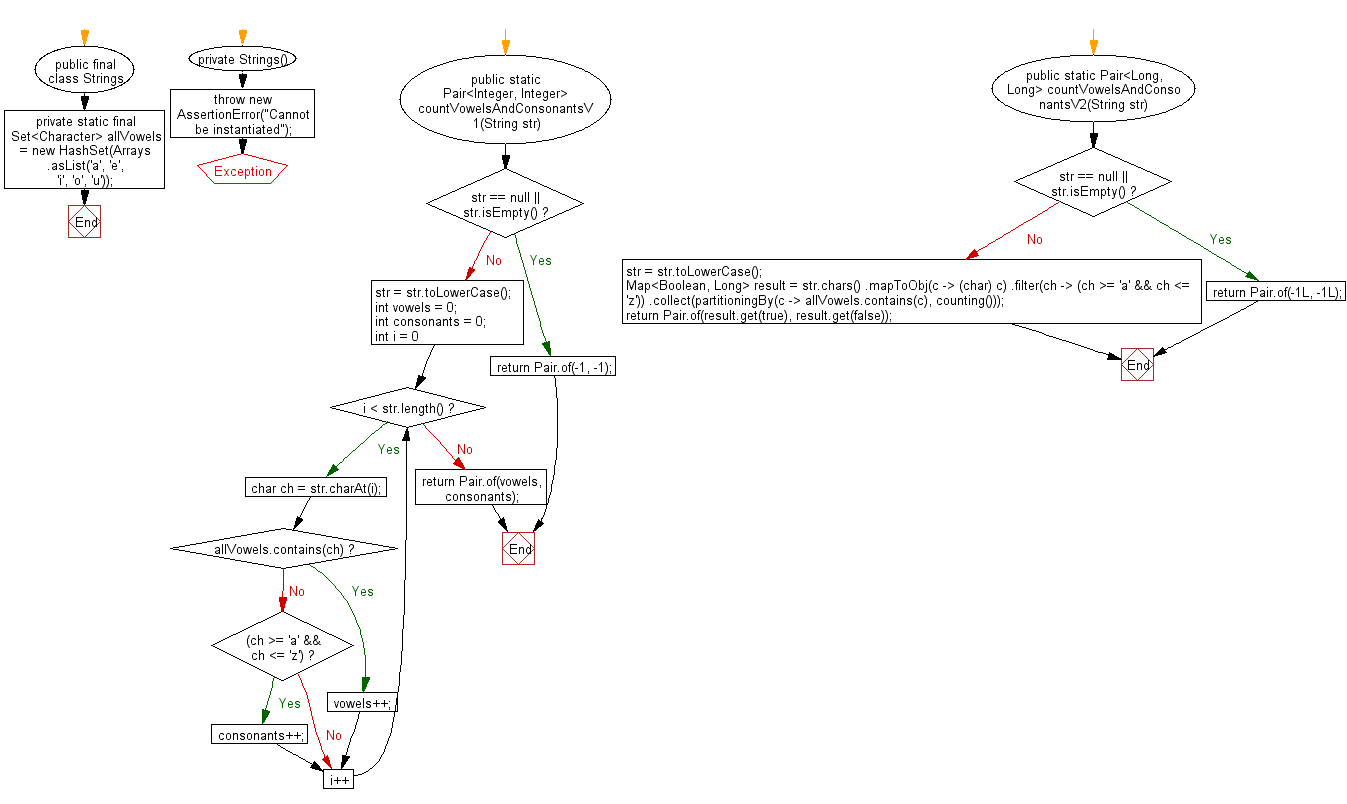Java: Count all vowels in a string
Count Vowels in String
Write a Java method to count all vowels in a string.
Sample Solution:
Test Data:
Input the string: w3resource
Pictorial Presentation:

Sample Solution:
Java Code:
import java.util.Scanner;
public class Exercise4 {
public static void main(String[] args)
{
Scanner in = new Scanner(System.in);
System.out.print("Input the string: ");
String str = in.nextLine();
System.out.print("Number of Vowels in the string: " + count_Vowels(str)+"\n");
}
public static int count_Vowels(String str)
{
int count = 0;
for (int i = 0; i < str.length(); i++)
{
if (str.charAt(i) == 'a' || str.charAt(i) == 'e' || str.charAt(i) == 'i'
|| str.charAt(i) == 'o' || str.charAt(i) == 'u')
{
count++;
}
}
return count;
}
}
Sample Output:
Input the string: w3resource Number of Vowels in the string: 4
Flowchart:

Count the Vowels And Consonants in a string
Main.java Code:
//MIT License: https://bit.ly/35gZLa3
import java.util.concurrent.TimeUnit;
public class Main {
// 14 vowels, 19 consonants
private static final String TEXT = " ... Illinois Mathematics & Science Academy ... ";
public static void main(String[] args) {
System.out.println("Input text: \n" + TEXT + "\n");
System.out.println("String.charAt() solution:");
long startTimeV1 = System.nanoTime();
Pair pairV1 = Strings.countVowelsAndConsonantsV1(TEXT);
displayExecutionTime(System.nanoTime() - startTimeV1);
System.out.println("Vowels: " + pairV1.vowels);
System.out.println("Consonants: " + pairV1.consonants);
System.out.println();
System.out.println("Java 8, functional-style solution:");
long startTimeV2 = System.nanoTime();
Pair pairV2 = Strings.countVowelsAndConsonantsV2(TEXT);
displayExecutionTime(System.nanoTime() - startTimeV2);
System.out.println("Vowels: " + pairV2.vowels);
System.out.println("Consonants: " + pairV2.consonants);
}
private static void displayExecutionTime(long time) {
System.out.println("Execution time: " + time + " ns" + " ("
+ TimeUnit.MILLISECONDS.convert(time, TimeUnit.NANOSECONDS) + " ms)");
}
}
Pair.java Code:
//MIT License: https://bit.ly/35gZLa3
public final class Pair<V, C> {
final V vowels;
final C consonants;
public Pair(V vowels, C consonants) {
this.vowels = vowels;
this.consonants = consonants;
}
static <V, C> Pair<V, C> of(V vowels, C consonants) {
return new Pair<>(vowels, consonants);
}
@Override
public int hashCode() {
return vowels.hashCode() ^ consonants.hashCode();
}
@Override
public boolean equals(Object o) {
if (!(o instanceof Pair)) {
return false;
}
Pair obj = (Pair) o;
return this.vowels.equals(obj.vowels)
&& this.consonants.equals(obj.consonants);
}
}
Strings.java Code:
//MIT License: https://bit.ly/35gZLa3
import java.util.Arrays;
import java.util.HashSet;
import java.util.Map;
import java.util.Set;
import static java.util.stream.Collectors.counting;
import static java.util.stream.Collectors.partitioningBy;
public final class Strings {
private static final Set<Character> allVowels
= new HashSet(Arrays.asList('a', 'e', 'i', 'o', 'u'));
private Strings() {
throw new AssertionError("Cannot be instantiated");
}
// Note: For Unicode supplementary characters use codePointAt() instead of charAt()
// and codePoints() instead of chars()
// Also, note that languages can have a different number of vowels and consonants
// (e.g., in Romanian there are 7 vowels: a, e, i, o, u, ă, î (â). Therefore,
// consider adjust the code accordingly.
public static Pair<Integer, Integer> countVowelsAndConsonantsV1(String str) {
if (str == null || str.isEmpty()) {
// or throw IllegalArgumentException
return Pair.of(-1, -1);
}
str = str.toLowerCase();
int vowels = 0;
int consonants = 0;
for (int i = 0; i < str.length(); i++) {
char ch = str.charAt(i);
if (allVowels.contains(ch)) {
vowels++;
} else if ((ch >= 'a' && ch <= 'z')) {
consonants++;
}
}
return Pair.of(vowels, consonants);
}
public static Pair<Long, Long> countVowelsAndConsonantsV2(String str) {
if (str == null || str.isEmpty()) {
// or throw IllegalArgumentException
return Pair.of(-1L, -1L);
}
str = str.toLowerCase();
/*
long vowels = str.chars()
.filter(c -> allVowels.contains((char) c))
.count();
long consonants = str.chars()
.filter(c -> !allVowels.contains((char) c))
.filter(ch -> (ch >= 'a' && ch <= 'z'))
.count();
return Pair.of(vowels, consonants);
*/
// or via partitioningBy()
Map<Boolean, Long> result = str.chars()
.mapToObj(c -> (char) c)
.filter(ch -> (ch >= 'a' && ch <= 'z'))
.collect(partitioningBy(c -> allVowels.contains(c), counting()));
return Pair.of(result.get(true), result.get(false));
}
}
Sample Output:
Input text: ... Illinois Mathematics & Science Academy ... String.charAt() solution: Execution time: 2905069 ns (2 ms) Vowels: 14 Consonants: 19 Java 8, functional-style solution: Execution time: 117485709 ns (117 ms) Vowels: 14 Consonants: 19
Flowchart:



For more Practice: Solve these Related Problems:
- Write a Java program to count both vowels and consonants in a given string and display the counts.
- Write a Java program to count the frequency of each vowel in a string, ignoring case differences.
- Write a Java program to determine if the total number of vowels in a string is a prime number.
- Write a Java program to count vowels in a string after removing all non-letter characters.
Go to:
PREV : Find Middle Character(s) of String.
NEXT : Count Words in String.
Java Code Editor:
Contribute your code and comments through Disqus.
What is the difficulty level of this exercise?
Test your Programming skills with w3resource's quiz.
